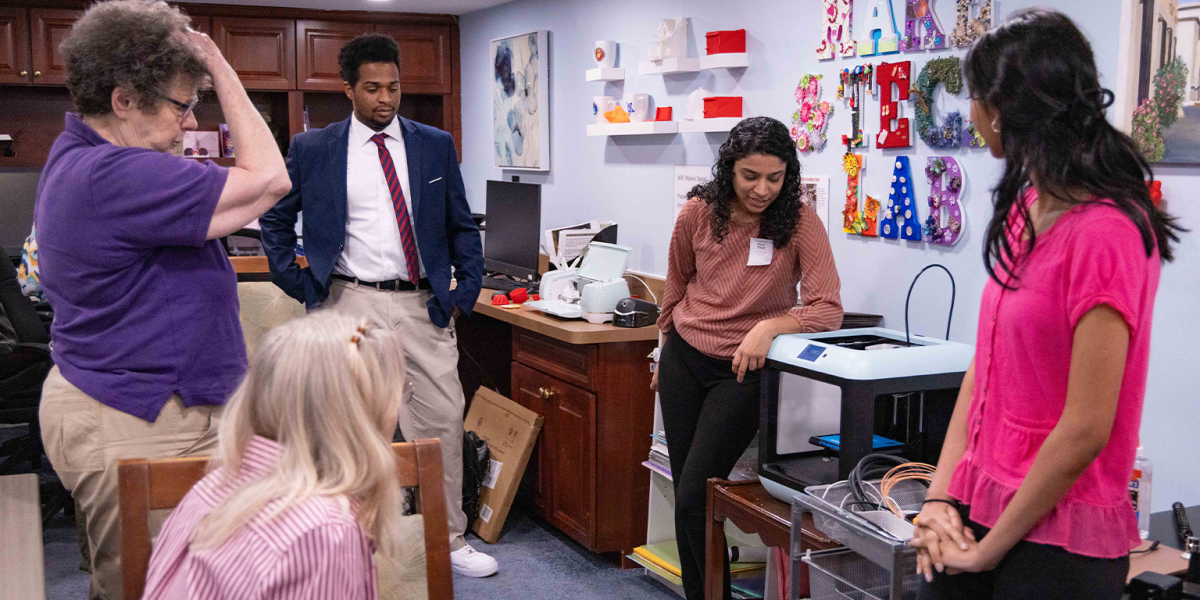At a local retirement community, a makerspace flips the script on aging and technology

Nupur Wagle, a master's student in human-computer interaction, demonstrates a 3D printer at a local retirement community while seniors and other students look on. Photo by: Will Campbell
A 3D printer whirred as a group of seniors gathered around an unfamiliar machine, watching layer after layer of plastic slowly accrete into an intricate object—part of a folding cell phone stand. One man squinted. “How does it know where to put the next layer?” he asked. Beside him, human-computer interaction graduate student Nupur Wagle grinned. “That’s the magic of the design file,” she explained, pointing to the digital blueprint on a screen.
This interaction was part of an ongoing collaboration between the University of Maryland’s College of Information and Knollwood, a Washington, D.C., retirement community exploring the potential of a makerspace for its residents. At the center of the project, which provides both high- and low-tech options for creation, is INFO Associate Professor Amanda Lazar, whose research focuses on understanding how to design accessible technology for older adults—while challenging stereotypes about aging.
A Makerspace Built on Community Needs
The makerspace—equipped with a 3D printer, Cricut machine, sewing equipment, and more—was the brainchild of Nancy Roderer MLS ’73, a Knollwood resident who envisioned it as a way to foster creativity and connection. “People come here to be part of a community,” Roderer says. “This was another way to encourage collaboration.”
But introducing new technology to seniors hasn’t always been straightforward. The 3D printer, in particular, posed challenges. Some residents questioned its usefulness (“I don’t need more plastic trinkets,” one remarked), while others struggled with its finicky mechanics.
That’s where Lazar’s team stepped in—not as outside experts dictating solutions, but as partners. “We’re following the lead of the community,” Lazar explains. Her approach, participatory action research, means working closely with residents to co-design instruction manuals, troubleshoot problems, and identify real-world uses for the technology.
Intergenerational Support
High school volunteer Evan Brown, who worked last summer with Lazar’s research group in The Health, Aging, and Technology (THAT) Lab, saw firsthand how differing generational perspectives benefited the project. During a demo on 3D printing, some residents were intrigued by the idea of creating lithophane lamps (3D-printed images that glow when backlit). But others were skeptical—until Brown reframed the discussion.
“You garden, don’t you?” he asked one woman. “You could 3D print a trowel instead of buying one.” Suddenly, the possibilities clicked. “It wasn’t about convincing them,” Brown says. “It was about showing them how it could fit into their lives.”
For Lazar and the students involved in her research, these interactions underscore a key insight: Older adults aren’t passive recipients of technology, but active participants with diverse interests and complex lives.
“They have their own schedules, hobbies, and needs,” Brown reflects. “They’re not just reminiscing; they’re living their lives.”
The Bigger Picture: Designing with, Not for
Beyond 3D printing, the makerspace project has sparked broader conversations about how technology should be introduced to older adults. Traditional approaches often assume seniors need to be “taught” tech, but Lazar’s team emphasizes mutual learning. When residents co-designed sewing machine manuals, for instance, they often taught the researchers—not the other way around.
Lazar also sees potential in embedding students in senior communities as tech-support liaisons. “It’s a two-way relationship,” she says. Students sharpen communication skills, while residents gain tailored assistance.
As the makerspace evolves, so do its projects—like creating emergency pet tags for residents’ doors or crafting holiday gifts. For Roderer, the real success isn’t just the gadgets but the connections formed. “Dr. Lazar’s team has been terrific,” she says. “We’ve benefited so much from this collaboration.”